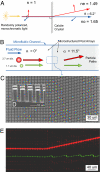Hydrodynamic metamaterials: microfabricated arrays to steer, refract, and focus streams of biomaterials
- PMID: 18495920
- PMCID: PMC2396696
- DOI: 10.1073/pnas.0712398105
Hydrodynamic metamaterials: microfabricated arrays to steer, refract, and focus streams of biomaterials
Abstract
We show that it is possible to direct particles entrained in a fluid along trajectories much like rays of light in classical optics. A microstructured, asymmetric post array forms the core hydrodynamic element and is used as a building block to construct microfluidic metamaterials and to demonstrate refractive, focusing, and dispersive pathways for flowing beads and cells. The core element is based on the concept of deterministic lateral displacement where particles choose different paths through the asymmetric array based on their size: Particles larger than a critical size are displaced laterally at each row by a post and move along the asymmetric axis at an angle to the flow, while smaller particles move along streamline paths. We create compound elements with complex particle handling modes by tiling this core element using multiple transformation operations; we show that particle trajectories can be bent at an interface between two elements and that particles can be focused into hydrodynamic jets by using a single inlet port. Although particles propagate through these elements in a way that strongly resembles light rays propagating through optical elements, there are unique differences in the paths of our particles as compared with photons. The unusual aspects of these modular, microfluidic metamaterials form a rich design toolkit for mixing, separating, and analyzing cells and functional beads on-chip.
Conflict of interest statement
The authors declare no conflict of interest.
Figures







References
-
- Newton I. Walford, London: 1704. Opticks or a Treatise of the Reflections, Refractions, Inflections and Colours of Light.
-
- Squires TM, Quake SR. Microfluidics: Fluid physics at the nanoliter scale. Rev Mod Phys. 2005;77:977–1026.
-
- Atencia J, Beebe DJ. Controlled microfluidic interfaces. Nature. 2005;437:648–655. - PubMed
-
- Huang LR, Cox EC, Austin RH, Sturm JC. Continuous particle separation through deterministic lateral displacement. Science. 2004;304:987–990. - PubMed
-
- Saleh BEA, Teich MC. Fundamentals of Photonics. New York: Wiley; 1991.
Publication types
MeSH terms
Substances
Grants and funding
LinkOut - more resources
Full Text Sources
Other Literature Sources

